Search Results
Not One More Girl safety events planned at two BART stations 9/28 and 10/5
BART officials will be joined by community partners at two safety events as part of the Not One More Girl initiative to educate riders about safe bystander intervention tactics and preventing sexual harassment on BART.
Event Details
- Thursday, September 28, 2023, at Downtown Berkeley BART Station from 12pm-3pm. View the Flyer.
- Thursday, October 5, 2023, at Lake Merritt BART Station from 12pm-3pm. View the Flyer.
The Not One More Girl team will host these "Bystander Safety Zone" events to hand out our new bystander intervention safety cards and other informational material from the campaign, while speaking to riders about tangible things we all can do to make BART safer for youth.
Not One More Girl is a BIPOC youth-led initiative in partnership with community-based organizations and BART to end gender-based violence. Phase II of the campaign launched last month.
- View a PDF of the "I Got You" bystander intervention card.
- View a PDF of the "You Got Me?" bystander intervention card.
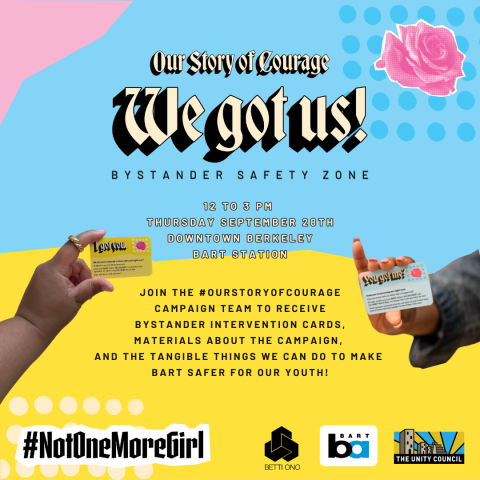
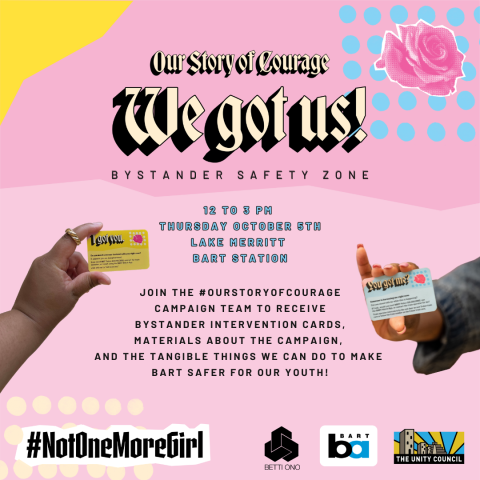
Bystander Intervention Cards for Riders
Two distinct wallet-size cards are now available to riders to discreetly hand to people to signal they need help or support, or to notify someone being harassed that you are there to help and support them.
These new bystander intervention cards are a concept developed by the youth design team, who expressed the need for options when asking for help or approaching a situation of potential harm. The cards include the slogans “I Got You” and “You Got Me?” with a list of actionable items riders can take to help a situation, from reporting the harassment to simply standing with someone. As young people are still trying to find their voices and figuring out how to navigate and decipher harassment, a physical card you can hand someone is an effective tool to precipitate the shift from being a bystander to becoming an agent of change.
The cards are available for pick up at each Station Agent booth at BART, and Ambassadors and Crisis Intervention Specialists will carry the cards and give them out when engaging riders. BART and the Betti Ono Foundation will also work to distribute the cards to youth through community organizations, events, and schools.
Bystander Intervention
Not One More Phase II
Addressing Harassment on BART
Around the Bay this Weekend: Sept. 11 schedule change, family-friendly scavenger hunt, and Oakland Pride
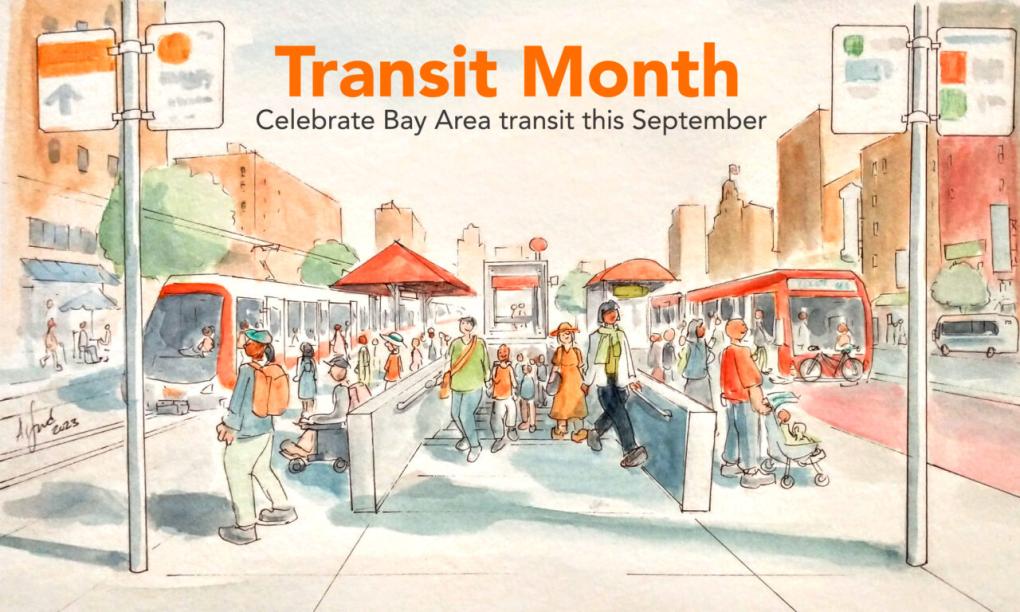
More than 219,000 of you rode BART this long weekend – to barbecues, to hikes, to watering holes, and perhaps to check off some sites for the Transit Month BART Scavenger Hunt (hosted by YPT SF Bay).
Speaking of Transit Month, the celebration of regional transportation is fast underway. Keep with Transit Month events -- and hit the ground running on the Ride Contest – to keep your calendar booked in the waning weeks of summer.
Around BART, some exciting changes are afoot, including our new-and-improved schedule, launching next Monday, Sept. 11. To learn more, watch our explanatory (and entertaining) video and reference this article. We’re think you’re going to like the changes, which emphasize weekend and weeknight service.
We're also proud to announce that last week BART, community partners, and local youth launched Phase II of our groundbreaking Not One More Girl initiative that addresses sexual harassment and gender-based violence on BART with new strategies to build a culture of supporting girls and gender-expansive youth when riding transit. The second phase of the award-winning initiative places emphasis on enabling people to have a greater sense of empowerment in a harassment situation and exhibits tools that fellow riders can use to provide support when harassment occurs. Read more about the initiative here and scroll to the bottom of this article to view the new art by local artist and muralist Safi Kolozsvari Regalado.
For an in-depth listing of local events, visit the BARTable website. We publish a weekly event roundup, BARTable This Weekend, that highlights happenings around the region as well as cool contests and sweepstakes from our partners.
Sunday, Sept. 10: Oakland Pride and Pridefest Oakland
Oakland Pride and Pridefest Oakland have joined forces for a joyous celebration of the LGBTQ+ community on Sunday, Sept. 10 from 12pm to 6pm in Uptown Oakland. The festivities commence with a parade celebrating LGBTQ+ lives and resilience from 11am to 12pm. Keep an eye out for the BARTmobile during the parade in its special Pride hat.
September through October 16: Explore the Bay Area on BART, Win Prizes with Agents of Discovery
From September through October 16, BART has partnered with Bay Area Explorer 4.0. a campaign that uses AR gaming to help kids engage in free outdoor learning experiences using their phones or their parents’ phones. Think Pokémon Go, but for parks and education.
Anyone can join by downloading the free Agents of Discovery mobile app and completing “missions” made up of educational “challenges” that teaches children about local history, culture, ecosystems, and safety.
BART launched four missions for riders that will take them on a fun and educational journey from Warm Springs to San Leandro, Millbrae to Daly City, North Concord to Rockridge and Richmond to Ashby.
Players, or “agents,” who complete missions will receive rewards as they play and earn the chance for big prizes like a $250 Clipper Card.
Learn more on BARTable.
Share Your BART Story at bart.gov/YourStory
This week, we launched a call for riders' BART stories. We want to hear what BART means to you and gain insight into how we can continue to improve.
Do you have a favorite BART memory? Have you met a dear friend or life partner aboard a train? Did you take BART to a seminal life event? Have you been sitting on a unique idea to improve the system? We’d like to hear it.
To answer our questions, visit bart.gov/YourStory. Once you've completed the questions, you can enter to win one of three $100 e-gift cards. Respondents have the option to remain anonymous.
Weekend Listen: All About the Schedule Change with BART’s Manager of Scheduling and Planning
In lieu of our typical Weekend Read we’ve got a Weekend Listen for you. BART’s podcast series, "Hidden Tracks: Stories from BART,” recently released a new episode all about the reimagined new schedule, featuring an interview with BART’s charismatic Manager of Scheduling and Planning, John FitzGibbon. Listen and/or read the transcript here.
Nosh on Ice Cream at BARTable Creameries
Summer officially ends Friday, Sept. 22, so you might want to seize the high temps while they're here and get yourself some ice cream from the Bay Area’s BARTable creameries. From Italian-style gelato to Japanese green tea soft serve, head to a BARTable ice cream shop this weekend and reference our curated roundup here.
Sweepstakes Spotlight: Win Glasses and Tickets to the Lafayette Art & Wine Festival
Enter to win two glasses and drink tickets to the Lafayette Art & Wine Festival that will take over the streets of downtown Lafayette on Saturday and Sunday, Sept. 23 and 24.
Enter to win by Sunday, Sept. 10 on the BARTable Contests and Deals page.
Read BART’s Safe & Clean Plan
Happy Riding this Weekend!
We hope you enjoy your weekend adventures aboard our trains.
Stay in touch by signing up for the BARTable This Weekend newsletter on the BARTable website – your one-stop shop for all things accessible by BART. You can also keep up with BARTable on Facebook and Instagram.
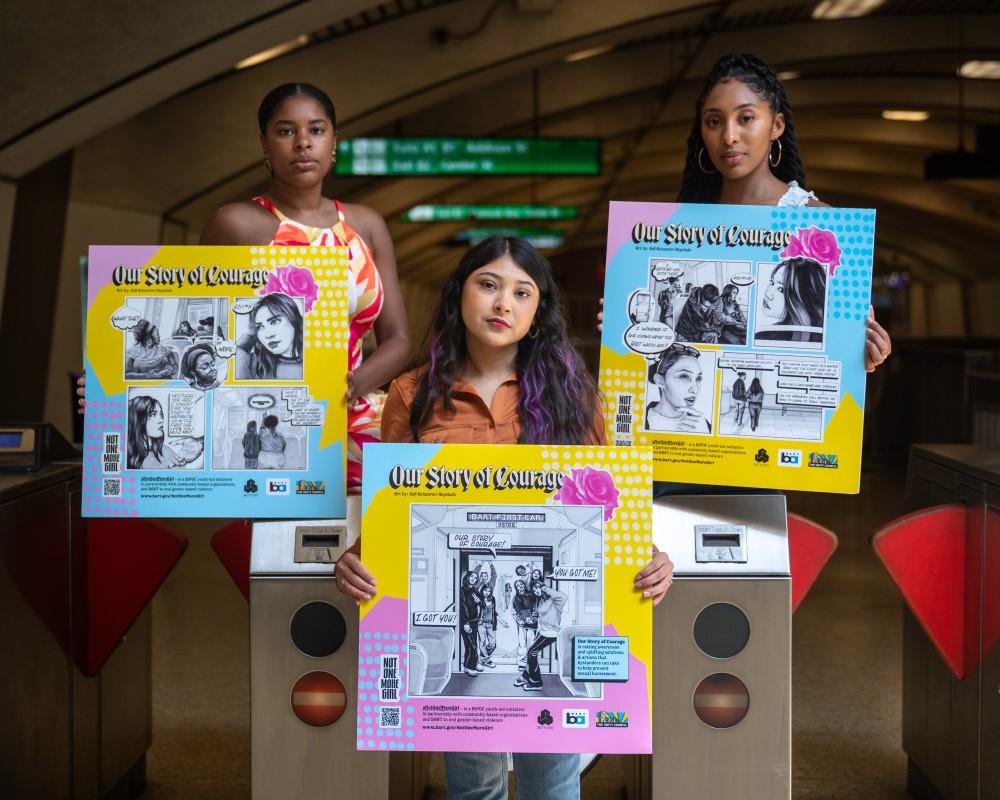
Some of the leaders of Not One More Girl Phase II pose with the project’s new art posters (Art by Safi Kolozvari Regalado). From left to right: Malkia Chionesu, development and purpose alignment consulting with M.CHIO; Gaby Guzman, Latinx Mentoring and Achievement Coordinator of Youth Services with The Unity Council; and Franchesca Rodriguez, Betti Ono Transit Justice Community Engagement Facilitator and graduate student at UC Berkeley’s Department of City & Regional Planning.
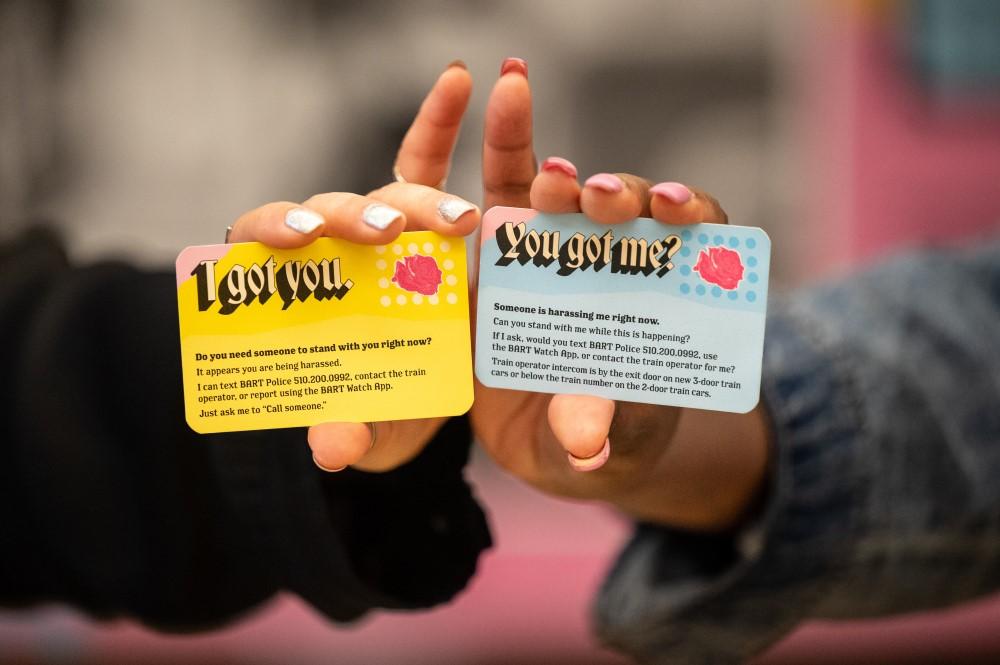
Bystander intervention cards that were launched as part of Not One More Girl Phase II. The two distinct wallet-size cards are now available to riders to discreetly hand to people to signal they need help or support, or to notify someone being harassed that you are there to help and support them. They are available for pickup at Station Agent booths.